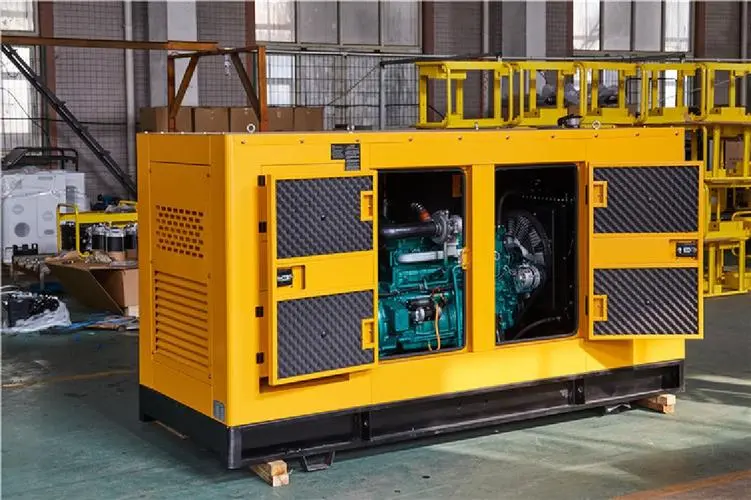Diesel Generator for Microgrid Applications Powering the Future of Energy

Introduction
In recent years, there has been a growing interest in microgrid systems as a way to enhance energy resilience, improve energy efficiency, and integrate renewable energy sources into the existing grid infrastructure. One key component of many microgrid systems is the diesel generator, which plays a crucial role in providing reliable backup power and balancing the supply and demand of electricity within the microgrid. This article will explore the role of diesel generators in microgrid applications, their benefits and challenges, and their potential to shape the future of energy distribution.
Overview of Microgrid Systems
A microgrid is a localized group of electricity sources and loads that can operate independently of the main grid or in conjunction with it. This flexibility allows microgrids to increase energy security, reduce costs, and improve the integration of renewable energy sources. Microgrid systems typically consist of a combination of distributed energy resources such as solar panels, wind turbines, energy storage systems, and backup generators.
The Role of Diesel Generators in Microgrid Applications
Diesel generators are a common backup power source in microgrid systems due to their reliability, efficiency, and ability to provide power during grid outages. These generators are typically fueled by diesel, which is readily available and can be stored for long periods without degradation. In a microgrid setting, diesel generators can be started automatically when there is a disruption in the main grid supply or when demand exceeds the capacity of renewable energy sources.
Benefits of Diesel Generators in Microgrid Applications
1. Reliability: Diesel generators are known for their reliability and can provide continuous power for extended periods, making them an ideal backup power source in microgrid applications.
2. Fast Start-up Time: Diesel generators have a quick start-up time, allowing them to respond rapidly to changes in demand or supply within the microgrid.
3. Fuel Availability: Diesel fuel is widely available and can be stored on-site, ensuring a constant fuel supply for the generator.
4. Cost-Effectiveness: Diesel generators are cost-effective to install and maintain compared to other backup power sources, making them an attractive option for microgrid developers.
5. Power Quality: Diesel generators can provide stable and consistent power output, ensuring a reliable electricity supply for critical loads in the microgrid.

Challenges of Diesel Generators in Microgrid Applications
While diesel generators offer many benefits for microgrid applications, there are also some challenges that need to be addressed:
1. Environmental Impact: Diesel generators emit greenhouse gases and pollutants during operation, contributing to air pollution and climate change. To mitigate these environmental impacts, microgrid developers can explore cleaner fuel options or incorporate emission control technologies.
2. Fuel Dependence: Diesel generators rely on a steady supply of fuel, which can be a challenge in remote or off-grid locations. To address this issue, microgrid systems can integrate multiple fuel sources or incorporate energy storage systems to reduce fuel consumption.
3. Maintenance Requirements: Diesel generators require regular maintenance to ensure optimal performance and reliability. Microgrid operators need to establish a maintenance schedule and have trained personnel available to address any issues that may arise.
4. Noise and Vibration: Diesel generators can generate noise and vibrations during operation, which can be a concern in residential or sensitive environments. 400kW generator fuel consumption rate and vibration isolation measures can help minimize these impacts.
Future Trends in Diesel Generator Technology for Microgrid Applications
As the demand for microgrid systems continues to grow, there is a need for innovative technologies to enhance the performance and efficiency of diesel generators in microgrid applications. Some of the future trends in diesel generator technology include:
1. Smart Grid Integration: Diesel generators can be integrated with smart grid technology to enable real-time monitoring and control of power generation and distribution within the microgrid. This integration can improve system efficiency, reduce downtime, and optimize fuel consumption.
2. Hybrid Systems: Hybrid systems that combine diesel generators with renewable energy sources and energy storage systems are becoming increasingly popular in microgrid applications. These systems can enhance energy resilience, reduce fuel consumption, and minimize environmental impacts.
3. Advanced Fuel Options: Alternative fuel options such as biodiesel, synthetic diesel, and hydrogen can help reduce the environmental footprint of diesel generators in microgrid applications. These fuels offer cleaner combustion and lower emissions compared to traditional diesel fuel.
4. Energy Management Systems: Energy management systems can optimize the operation of diesel generators in microgrid applications by forecasting energy demand, scheduling generator start-up and shutdown times, and coordinating with other distributed energy resources.
5. Remote Monitoring and Diagnostics: Remote monitoring and diagnostics technologies can enable real-time performance monitoring of diesel generators, allowing operators to identify potential issues and proactively address maintenance needs.
Conclusion
Diesel generators play a vital role in microgrid applications by providing reliable backup power, balancing supply and demand, and enhancing energy resilience. While diesel generators offer numerous benefits for microgrid systems, there are also challenges related to environmental impact, fuel dependence, maintenance requirements, and noise generation. By addressing these challenges and embracing future trends in diesel generator technology, microgrid developers can unlock the full potential of these power sources to shape the future of energy distribution. Diesel generators will continue to play a significant role in powering the transition to a more sustainable and resilient energy future.
